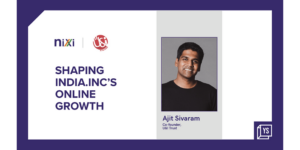An initiative of Nandi Nandan Breeds and Seeds, PashuBajaar wants to optimise and bring about transparency in livestock trade by connecting farmers directly with the consumers.
The initiative has empowered women with a new role as goat traders, thereby improving their social status and making them financially independent.
“Selling goats was a challenge earlier as the trader used to promise high rates for the buck but he used to return when the buck was sick and give reasons to pay very less. There was no predictability of either the health of the goat or its market price,” says Rita Devi who is now a proud Pashu Sakhi.
‘Pashu Sakhis’ (friends of livestock) are trained in general practices of goat-keeping, common diseases, and their treatment. They are educated on the benefits of various goat feed products that can help in increasing the weight of the goat to keep them healthy. Post training, the Pashu Sakhi is also given financial assistance to build a goat keeping unit and materials to undertake activities such as regular weighing of goats.
On-ground implementation and success
PashuBajaar was founded on the basis of the absence of formal players, especially aggregators at the backend who could ensure transparent pricing and enhance efficiency of acquisition of livestock by using digital tools and platforms. The implementation of the Krishi Mangal initiative helped in benefitting 1,196 goat rearers and creating 110 jobs throughout the goat value chain. The program also helped facilitate 350 microentrepreneurs, enabling sustainable livelihood opportunities throughout the sector.
“Developing a reasonable pricing system for the goats and bucks – using equations that are based on the live weight of empty stomach goats along with keeping in mind the grading of goats – has been one of the biggest milestones for PashuBajaar,” says Sanjeev Kumar, Founder and Advisor, PashuBajaar. A major outcome of live body-weight pricing has been an almost 10 percent increase in the cost of goats and buck. This has not only helped in increasing the farmer’s annual income but also enhanced their negotiation power and reduced bargaining time between goat farmer and trader.
“Now (post Krishi Mangal project), we are more aware of the price of our goat and we can talk with traders on the minimum price,” said Rajender, goat trader from Village Undera in Gujarat. This technique has also been adopted by many other players like the government and non-government organisations while procuring goats.
Using code-based communication to identify sellers and link them with potential buyers has been another big on-ground success. PashuBajaar developed a code like sex, teeth, grade, weight, price (M*02*A*25*7500) to quickly share details and get decoded for trading. This has made the entire selling process uniform and efficient. PashuBajaar has also established links with large meat companies and signed an MoU to ensure regular supply of goats at LBW-based price.
Navigating challenges
Despite supporting over 100 million livelihoods, Indian livestock trade has seen the least use of technology to make it efficient and effective for the farmers. Instead of trying to replace local traders and investing in huge amounts, PashuBajaar realised that efforts need to be channelised to correct market anomalies.
One of the biggest challenges undertaken was to understand the goat pricing system and develop a live body pricing system for goats, which is reasonable and acceptable to farmers as well as traders. Implementing efficient, transparent, and equitable market measures on the ground involved challenges on many fronts. Some of the major challenges faced by PashuBajaar have been interaction and education of the farmer, as well as training and communication with the Pashu Sakhi.
Building simple processes and systems that can be owned and effectively managed by the community was another big task at hand. However, solid ecosystem partnerships have helped them navigate through all these with ease. As the market has been informal, a lot of resources were required to pilot things and generate evidence, and that’s where partnerships with local veterinarians and call centres have helped them to pilot and find the right mechanism.
“Earlier, the doctor did not visit the village and we had to travel far with our sick goats/kids. Now the treatment is fast and our goats are saved often because of quick treatment,” shared Sohanlal, a farmer in Rajwapur Village in Uttar Pradesh.
Thanks to the availability of timely treatment, the reduction in goat mortality rate has come down from 30 percent to 6.8 percent which translates to saving two goats per year, resulting in an income increase of Rs 7,000 for the farmers. The kid mortality rate which was at a staggering 48 percent has come down to 8.5 percent, resulting in saving at least two kids per year translating into an increase of Rs 3,000 for the farmers.
Added to this, the overall enhancement in quality of the kids and the implementation of live body weight pricing, ensured that goat rearers can earn an additional Rs 15,555 to their existing income.
Along with that, ecosystem partnerships have also helped to ensure integration of backend services like doorstep access to production technology, training and capacity building of last mile delivery cadres, and sensitising banks and financial institutions for enhanced access to finance.
As a result, banks have signed an MoU with PashuBajaar to provide loans to goat farmers and over 30 lakhs has already been released as loan amount. The MoU covers over 2600 bank branches, making loans easily accessible to the community.
Support from Krishi Mangal
Krishi Mangal has helped PashuBajaar in consolidating their model, launching pilots in concentrated patches, and most importantly, to pilot a few initiatives on the market front to find the right strategies and sharpen business operations.
“The program support came to us at a very critical stage of process standardisation and testing it to scale to conduct some field pilots and generate experiences to fine-tune strategies,” says Sanjeev.
PashuBajaar has been successful in executing its vision, thanks to back-end and front-end support provided by Krishi Mangal. The program has rolled out special incentives and innovative support to the front-end, along with providing documentation support as well as integrating services at farmer level. Engagement with Cisco mentors during the course of the program helped PashuBajar leverage domain expertise and strong market knowledge. Cisco not only allocated funds for growth and development, but also helped with their monthly reviews and mentoring on how to organise the working capital to gain maximum benefit along with identifying and aligning information gaps.
PashuBajaar envisions building India’s largest online platform for livestock trading. It aims to not only enhance the income of farmers, but to also provide assured, health-certified quality breed to meat startups and commercial livestock farmers.
MGNREGA (Mahatma Gandhi National Rural Employment Guarantee Act) has sanctioned funds for 25 large livestock trade centres worth Rs 1250 lakh post seeing the success of the model. The Ministry of Rural Development has documented and published a video of the work done by PashuBajaar, commending their efforts in enhancing rural lives.
With the use of the right technology and data analytics, PashuBajaar is all set to make goat farming a systemic and risk-managed livelihood for millions, generate employment in the value chain, and create a dynamic socio-economic impact on the ecosystem at large.










